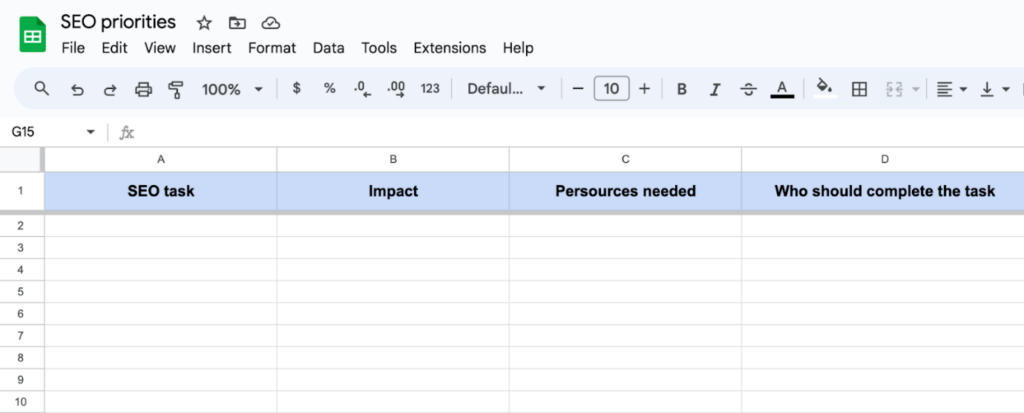Let’s face it: there are a lot of different strategies you can employ to improve your SEO. That’s why SEO is now considered its own industry.
It’s why SEO companies are popping up left and right, and as long as Google keeps evolving, it’s also why so many businesses need to have a solid SEO strategy that caters to their needs. Prioritizing tasks is the backbone to making this happen.
However, the truth is that every business is going to have different priorities – there is no one-size-fits-all approach. While certain SEO tasks will naturally take priority over others for every company (for example, getting rid of duplicate content and guest posting), many of the various tasks in between will differ.
It’s therefore important to understand how to prioritize SEO tasks so you can create a custom plan of action for your business.
Steps to Prioritizing SEO Tasks for Your Specific Business
Before doing anything, set up a spreadsheet to record all of the information you’re about to put together (in the next section).
I personally like to use Google Docs because it allows different people to edit and work in the document and see changes in real-time. Split the spreadsheet up into the following five categories:
- SEO task
- Impact
- Persources needed
- Costs
- Who should complete the task

Once you have your spreadsheet set up, it’s time to fill it in with facts. Below are a few tips to help set your priorities.
1. Create a solid set of tasks that need to be completed
Include everything you possibly can, even if something is already considered “completed.”
After all, you can’t start prioritizing tasks if you don’t know what they are. Start with the big SEO tasks such as link removal, internal linking, content removal and publishing and design. Once you have your big tasks out of the way, focus on smaller SEO tasks such as A/B testing certain headlines and optimizing your videos and images.
It helps to have each department and marketing employee create a list of all the small SEO tasks that need to be done. While this might seem like a lot of work or a waste of time for everyone, you will be surprised at how many different tasks people come up with when brainstorming.
You may have duplicates, but chances are each person will have something unique to contribute to your list. This ensures that you don’t miss a beat and you can get it done right the first time.

Tip: If you do use Google Docs, simply give each person or department temporary access to the document. They can then go in and add their tasks while seeing what others have added, which will cut down on duplicates.
2. Split up your tasks into three groups: High, Medium or Low impact
This step helps you break up how you want to prioritize. While it’s tempting to take your list and simply start trying to put things in order, this can lead to errors. The less data you have to work with, the better chance you have at accuracy, and categorizing all of the tasks is a great way to make this happen.
However, once you have everything sectioned off into these three categories (or more if you prefer), you’re not done. You have a few other issues to consider aside from just the impact they have on your website.
3. Write down all of the resources and costs needed to complete each task
Sometimes the resources you need to get a task done will determine where you want to prioritize it. For example, if you know that you want to start including more content on your website’s blog, you may need to hire more writers download a content management system, and teach someone how to manage that system.
If you know that you have broken links on a few of your pages, all you’ll need to do is have someone fix the links. The latter is much faster, and although the first task might have a higher impact, you may still want to prioritize that second task above the fist.If you’re seeking experienced local agencies, such as an Shout SEO Melbourne team , SEO company in Sydney or an SEO agency in Perth, discover further details right away.
The same can be said for cost. Depending on your budget, something that costs a lot of money might be moved to a lower priority status than something that is free but has the same impact.
4. Write down who will need to complete each task
Your marketing team will most likely take the bulk of the work, but sometimes IT or design teams might be the best option for the job. By writing down who should complete which task, you can again start to make your data smaller.
I recommend taking this data and creating a new tab in your spreadsheet for each department or person. This way you can prioritize tasks for each department, thus getting them finished faster because two people can work at once! See how your spreadsheet changes below:

As you can see the screenshot is on the tab for the Content Team. All I had to do was move over everything I labeled as “Content Team” in the Main Sheet over to this new tab. Adding a section for notes is also a good idea in case there are specifics you need to mention.
5. Analyze your data to create priorities and delegate work
Finally, once you have all of this information recorded, you can start putting together a real prioritized list. Ideally, you will have one list for each department – so overall you will have a few lists.
The best way to make this happen is to move all of your high, medium and low impact items together and then prioritize from there.
6. Go back and do it all over again in a few months.
You should constantly be re-prioritizing SEO tasks and evaluating the success of all the work you’ve done. This is called an SEO audit: it’s important because Google is constantly updating best practices, adding in new features and tools to utilize, and your rankings and audience may change enough that you need to take action somewhere on your website.
Fortunately, this will be easier once you’ve created your initial spreadsheet. Thinking of tasks that need to be completed will be limited to those that were discovered or created in the last few months as opposed to listing out all of the possible tasks. You’ll already have a spreadsheet started to look over and analyze, so it’s a much faster process.

